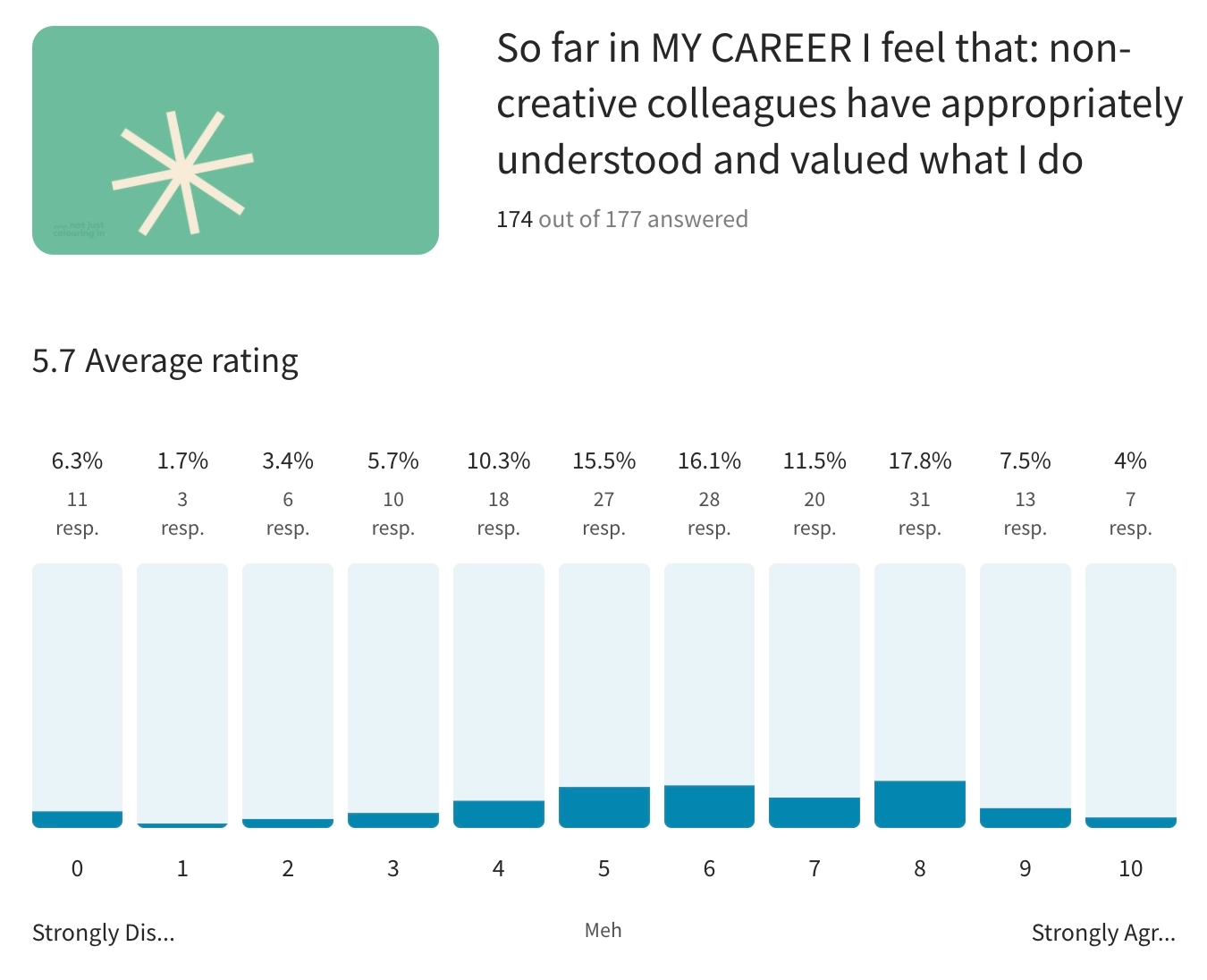NJCI Insights | Understanding and valuing creative contributions

TL:DR To foster a supportive and productive workplace, it's crucial for commercial colleagues to understand and value creative professionals, as highlighted by the NJCI survey where the average response was a concerning 5.7 out of 10 for feeling understood and valued.""

As a trained designer, you know your craft and produce excellent work. But why is it crucial to be understood by your commercially focused colleagues? While it feels good to be recognised and valued, the client's satisfaction might seem like the ultimate goal. However, that’s not entirely the case. We'll explore why it’s essential for your commercial counterparts to grasp what you do, but first, let’s review the NJCI findings on this topic.
We asked creatives: "So far in my career, I feel that non-creative colleagues have appropriately understood and valued what I do." The average response was a concerning 5.7 out of 10, highlighting a significant issue within the licensing creative professional community. Questions about creative autonomy and career challenges fared better, averaging around 7 out of 10. However, as shown in the graph, the responses to this specific question were notably less positive.
In this article, we’ll delve into broader research on the subject, provide recommendations for creatives, and offer guidelines to help demonstrate that their work is far more than ‘just colouring in.’
The Psychological Driver: Relatedness
Returning to Self-Determination Theory (discussed earlier in the section on creative autonomy), the relevant psychological driver here is relatedness — the need to feel connected, accepted, and part of a group. When creatives feel a sense of belonging and acceptance, their motivation and engagement naturally rise. This concept is backed by research: the American Psychological Association (APA) found that employees who feel valued report better physical and mental health, along with higher levels of engagement, satisfaction, and motivation. Moreover, a Harvard Business Review study revealed that employees with a strong sense of belonging take 75% fewer sick days, highlighting the tangible benefits of fostering a supportive and understanding work environment.
Survey Findings: A Mixed Bag
Our survey results, however, indicate that there is much room for improvement in this area. Nearly one in three respondents did not feel that their non-creative colleagues appropriately understood and valued their contributions, with 11 strongly disagreeing 😬. This sentiment was particularly pronounced among designers, product development professionals, and creative services managers. Only a small fraction — seven individuals — strongly agreed that they felt understood and valued throughout their careers.
Conversely, project managers reported feeling the most valued, likely due to the more universally understood nature of their roles. This contrast highlights a gap in awareness and appreciation for the more nuanced and specialised work that creatives do.
Bridging the Gap: Recommendations for Leadership
Here are some practical suggestions for leaders eager to proactively address this problem:
Give Creative Staff a Voice: Regularly provide opportunities for creative employees to voice their concerns and ideas without fear of repercussions.
Anonymous Feedback System: Implement a system that allows for honest input on workplace issues, ensuring that creatives feel heard and understood.
Recognition Program: Develop a program that publicly and internally highlights the contributions of creatives, boosting their visibility and appreciation.
Clear Career Paths and Development: Offer tailored career development opportunities, including mentorship programs, access to training and workshops, and chances to lead projects.
Encourage Cross-Departmental Collaboration: Increase the visibility of creative contributions by fostering collaboration between different departments and senior management.
Involve Creatives in Strategy: Ensure that creative staff are included in strategy meetings and decision-making processes that impact their work.
Supportive Work Environment: Create an environment that supports both creative collaboration and focused work, with flexible working hours and state-of-the-art tools.
High-Quality Feedback: Provide constructive and meaningful feedback to help creatives grow and feel valued.
Creative leads:
You are not just colouring in if … you’re playing an active role in advocating for your team's work and integrating this into business processes. The only way to have a say in strategic decisions is to show how valuable your department is.
Creative professionals:
You are not just colouring in if … you’re finding ways to work more collaboratively with your commercially focused colleagues. Be your own biggest cheerleader and establish that you are not a service element within the business.
Understanding is a two-way street. For both creative and commercial colleagues to maximise their potential, it's essential for each to understand the other's roles, responsibilities, and challenges. By implementing these recommendations, leaders can foster a more inclusive and supportive workplace where creative professionals feel understood, valued, and motivated. This cultural shift will benefit not only the creatives but also enhance overall organisational performance and innovation.
Want to be part of NJCI?
NJCI is focused on rewriting the narrative. You've shared your desire to shift the perception of creative departments—from being seen as a cost to manage, to being recognised and celebrated as key profit generators. The 2024 NJCI report is the first step toward making that shift a reality.
It’s essential to understand and value the role of creatives in brand licensing to drive innovation and business success. We’re here to empower creative teams, giving them the ability to advocate for a stronger voice and more influence in shaping the industry’s future.
Join NJCI by signing up here and get access to the report instantly. It's packed with insights from licensing creatives and includes Skew’s expert recommendations for what’s next.





